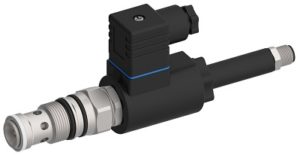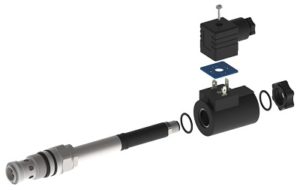Based on tried and tested cartridge-type directional seat valves, Bucher Hydraulics has developed a comprehensive valve family with a reliable system for monitoring operating position. The modular design reportedly lets users create individualized systems using high-performance valves that meet extreme requirements in mobile and industrial hydraulics—whether the focus is on energy efficiency, power density, intelligence or even to meet the requirements of Industry 4.0.

Series WR/WS directional seat valves from Bucher Hydraulics offer operating-position monitoring and are characterized by high power density
A good example, according to Bucher officials, is the concept of providing energy on demand. Processes with high repeat accuracy, such as those in injection-molding machines or presses, often achieve the desired performance in an energy-efficient manner by using a combination of valve-controlled accumulator operation and variable pump control.
If these machines also have a safety device, to ensure that interconnected tasks can only be carried out according to the “if-then” principle, complexity increases. The status of hydraulic valves must therefore be scrutinized and evaluated by a system for monitoring their operating position, to guarantee the safety of the operator and machine.
The company is a pioneer in the field of monitoring the operating position of cartridge-type two-stage directional seat valves. The know-how gained from demanding applications such as wind energy, where the valves have been used for years to control the pitch angle of turbine blades, has resulted in an adaptable portfolio of high-performance and reliable valves.
The technology for Industry 4.0 is in volume production today, and intelligent valves (the iValve family) are already being supplied to the lift/elevator industry. Thanks to sensors and self-learning algorithms, these valves can control and adjust themselves. Some of the resulting knowledge and experience has already been transferred to the modular cartridge valve system, where it can support intelligent controls for Industry 4.0.
Precision is also critical for directional seat valves. In the case of Bucher’s WR/WS series of valves, this has a direct effect on their power density, and it ensures the best possible performance, particularly in the relationship between switching capacity and ΔP. Even with a large stroke, the valve gives reliable switching over a long period of time, and pressure losses are kept to a minimum. Company engineers succeeded in designing the switching envelope so that the directional seat valve still functions reliably despite undervoltage, increased temperature and maximum pressure.
The WR/WS valves for years have proven themselves with long service life, leak tightness, high working pressure, closing speed, stability, and reserves of switching capacity, and have passed extensive EMC, shock and vibration tests. The valve’s design combines a small footprint with high flow, which often allows a smaller nominal size to be used versus similar competing valves. For example, a size 10 valve with an M24 thread has a rated flow of 140 lpm, and even with operating-position monitoring, the size 10 achieves 80 lpm. The size 5 valve is rated at 30 to 40 lpm, depending on the version.
Details make a difference, too, noted the company. Exacting seats and seat surfaces form the basis for a reliable design—even valves with just a unidirectional seat-type shut-off maintain their position at a low load pressure. This seat technology means that the WR valves are reliable components where stringent safety requirements have to be met. Alternatively, the WS version with bidirectional seat-type shut-off lets users achieve efficiency and safety with just one valve, because even low-loss circuits working in accumulator mode require no additional valves.

Modular design lets users build custom safety circuits from a range of valves, sensors and solenoid coils.
The WR/WS valve design also includes a special spool with only slight clearance, and its particular geometry provides a positive overlap with minimal spool-type leakage. As a result, the system that monitors the spool operating position can also be used as a safety device.
In addition, the electrical interface is an important safety aspect. Bucher Hydraulics offers a fail-safe sensor with PNP output (normally closed), which sends a positive signal to the control line. These valves can, therefore, also be used in mobile hydraulics. The modular system also allows for NPN and/or normally open outputs. However, this is advisable only after considering the overall safety aspects in close cooperation with the user.
The high-pressure wet armature solenoid system is also specifically tailored to the needs of users. The design differs significantly from other systems for monitoring operating position. The solenoid coil can be easily rotated and replaced, even during operation in the field. Because solenoid coils are fitted onto the cartridges and operate independent of the internal valve design, replacing them has no influence on the oil circuit and operating-position monitoring; and intricate dismantling of the electronics is not necessary. The Bucher Hydraulics modular system includes various voltages and connectors for the solenoid coil.
In general, users can build custom safety circuits using the three components of valve, sensor and solenoid coil. Flexibility and modularity allow the choice of cavity type, switching capacity, flow rate, ΔP, leak tightness, sensor function and signal type, number of flow paths as well as the selection of nominal size from 5 to 16. In addition, connectors featuring IP67 protection class and a special surface coating permit use in applications with not only extreme hydraulic loads, but also under aggressive environmental conditions. For this purpose, all external parts are protected against corrosion by a zinc-nickel finish, which has been tested to withstand a 720-hour salt spray test.
Bucher Hydraulics
www.bucherhydraulics.com
Filed Under: Mobile Hydraulic Tips